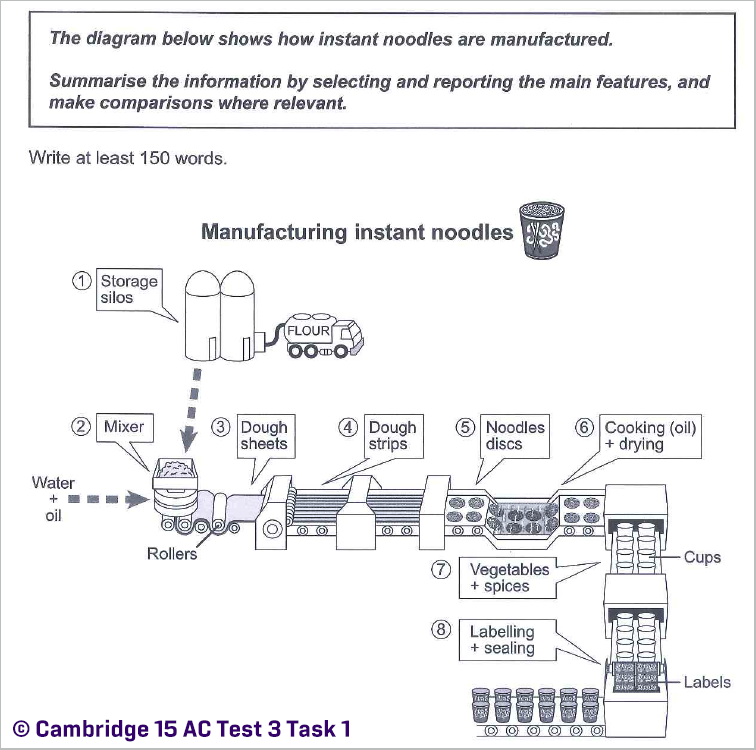IELTS Academic Writing Task 1: Process diagram from Cambridge 15 Test 3; instant noodles production; with tips and model answer
This IELTS Academic Writing Task 1 post is a presentation of answering a process diagram. A process diagram shows how a product is manufactured, recycled, or reused. In this post, I’ve selected the production or manufacture of instant noodles and the question is taken from Cambridge 15 Academic Test 3. Hopefully, this post will work as a guide for answering any process diagram easily.
Let’s have a look at the title of this Task 1 and the picture.

Here are the steps of writing the answer to a task 1.
1) Analyse the question
2) Identify the main features
3) Write an introduction
4) Write an overview
5) Write the body paragraphs to detail the picture.
For this question, we have to follow the following structure.
| Paragraph 1 | Introduction + Overview |
| Paragraph 2 | 1st half of the main features |
| Paragraph 3 | 2nd half of the main features |
When you are to answer a process diagram, think about the following points/ tips:
- A process has some stages that are orderly placed. So, your answer has to be started at the beginning, and you should explain each stage all the way through to the last one.
- The diagram will show you that there is a beginning point and an ending point.
- In a process diagram, you may need to look at the picture carefully as some stages might not be clearly explained and you need to find out the correct words or language for them.
- You must practice at least 5-10 different types of process diagrams to become skilled in writing the answer.
- Passive voice is often used in the description of the picture as the subject (the action performer) is not present in most cases. So, you should have a good idea about the passive voice.
- Your answer must contain linkers/discourse markers as this is a process. Here are some examples:
In the first stage, subsequently, then, next, after that, in the following step, finally, ultimately, etc.
Model answer:
The given diagram illustrates the methods by which instant noodles are manufactured. Overall, it is apparent that there are a total of 8 stages in this process, commencing with storing flour in silos and culminating in labeling and sealing cups.
The process initiates with flour being pumped from a truck into two silo towers for storage. Subsequently, the flour is sent to a mixer, where it is blended with a combination of water and oil. The next stage is rolling over the mixture repeatedly to form dough sheets and then the sheets are stripped into separate narrow and long pieces.
In the fifth stage of the process, these strips are moulded into many noodles discs which are then cooked in oil and left for drying. After that, vegetables and spices are added to these dried noodles discs after which they are put into different cups. Finally, the process concludes with the cups being labeled and sealed.
(156 words)
Examiner’s review:
This diagram presents a terse or brief introduction. The overall comment contains key features of the picture. The body paragraphs are well-organized and a number of linking devices are used flexibly yet in a controlled way. Passive voice is used as the subject is not present. The use of capitalization and spelling is correct. Collocations or word-associations are also used accurately and the answer looks lucid and striking.
It is a great answer that can achieve a band score of 8.5.
N.B: Please have a close look at the bold words. They make this writing stand out from others.
Here are some other diagrams that you can practice:
Flow-chart on sweater manufacturing
Process diagram on olive oil production
Two maps showing changes in an industrial village
Two maps showing changes in a town
Life cycle diagram on tuna fish
Life cycle diagram on silkworm moth
Cycle diagram on water movement
Diagram on water contamination
If you like this post, please make the comments below. You can also provide your opinions or ask relevant questions on Writing Task 1.




geat job